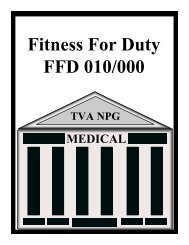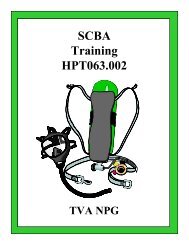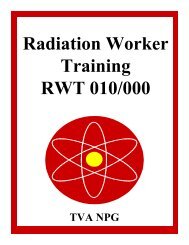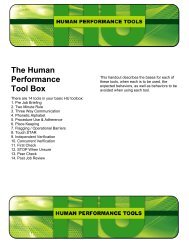Dynamic Learning Activity
Dynamic Learning Activity
Dynamic Learning Activity
- No tags were found...
Create successful ePaper yourself
Turn your PDF publications into a flip-book with our unique Google optimized e-Paper software.
Training Code of Conduct• Attend training as scheduled• Be on time!!!• Turn phones and pagers offor to vibrate• Adhere to managementexpectations• Respect the opinions of others• Be professional in behaviorand appearance• Come prepared to learn• Participate constructively• Use training to improve yourperformance• Provide honest andconstructive feedback to theinstructor• Submit training requests toaddress knowledge and skilldeficiencies• Actively participate in trainingcommittees• Follow all safety precautionswithout exception
Terminal ObjectiveUpon successful completion of this course, theparticipant will demonstrate knowledge of keyHuman Performance and Industrial Safety practicesand work expectations employed by Browns FerryNuclear Plant and within the Nuclear Power Group(NPG). Successful completion requires activeparticipation in the learning activities as determinedby the instructor(s), and successful completion of awritten examination with a passing score of at least80%.
Safety Message
ReminderSafety is everyone’s responsibility and right.“…the quality of being safe, freedom from danger or injury”Dictionary“The control of hazards to attain an acceptable level of risk”National Safety Council
How to Prevent Accidents• Hazard Recognition– Planning– Human performancetools• Hazard Elimination- If possible• Hazard Control– Engineering– Administrative– PPE
*Hazard Recognition*•Two categories of hazards inthe workplace:1. Unsafe Acts: Most accidents result fromthe actions of people and not necessarilythose who are injured.2. Unsafe Conditions: Physical hazards inthe workplace that must be identified andpromptly corrected.
What types of controls could be usedfor each of these hazard groups?• Electrical• Environmental• Fire• Material Handling• Tools & Equipment• Walking/WorkingSurfaces
Human Error PrecursorsWhat are error-likely situations?How do we avoid them?Examples of human errorprecursors:•Time pressure•Repetitive actions•Distractions•Heat stress work areas•Knowledge/skill level•Fatigue•Complacency
Pre-Job Briefing (PJB)• Best way to effectively communicate hazards.• Required for any activity categorized as a “job”.(Job - is defined in TVA Safety Procedure 18.005 as any operation,maintenance, testing, inspection, or construction activity that requiresemployees to handle material, use tools, conduct tests or usesupporting equipment such as ladders or scaffolds.)• Type of PJB depends on classification of job –low hazard or high hazard. Low hazard requiresonly a verbal PJB.-
Pre-job Briefing Checklist
Job Safety Analysis (JSA)No: Job:Date:Section: Skills Required:Analysis by: Reviewed by:Approved by:Required Personal Protective Equipment:Tools & Equipment Required:Job Preparation:Hazardous Materials:Special Requirements:No Sequence of Basic Job Steps Potential Accidents of Hazards Recommend Safe Job Procedures
What is intervention?What is coaching?• Intervention - Proactively stopping and/orredirecting actions to meet site standardsand expectations.• Coaching - Providing unsolicited feedbackin order to assist individuals in beingsuccessful in their job assignment.
Why do we need coaching?• Change behavior andimprove performance• Increase trust, candor,and cooperation• Take advantage ofavailable resources andget results• Help people learn tocoach themselves• Help each other succeed• Prevent errors
Post-Job Review• Evaluate work• Capture lessons learned• Discuss changes to be incorporated intowork package, procedure, and/or JSA.
DLC Walk-through• Required: hard hat, safety glasses, andgloves• Perform a self-check before beginning• Participation is not optional!








